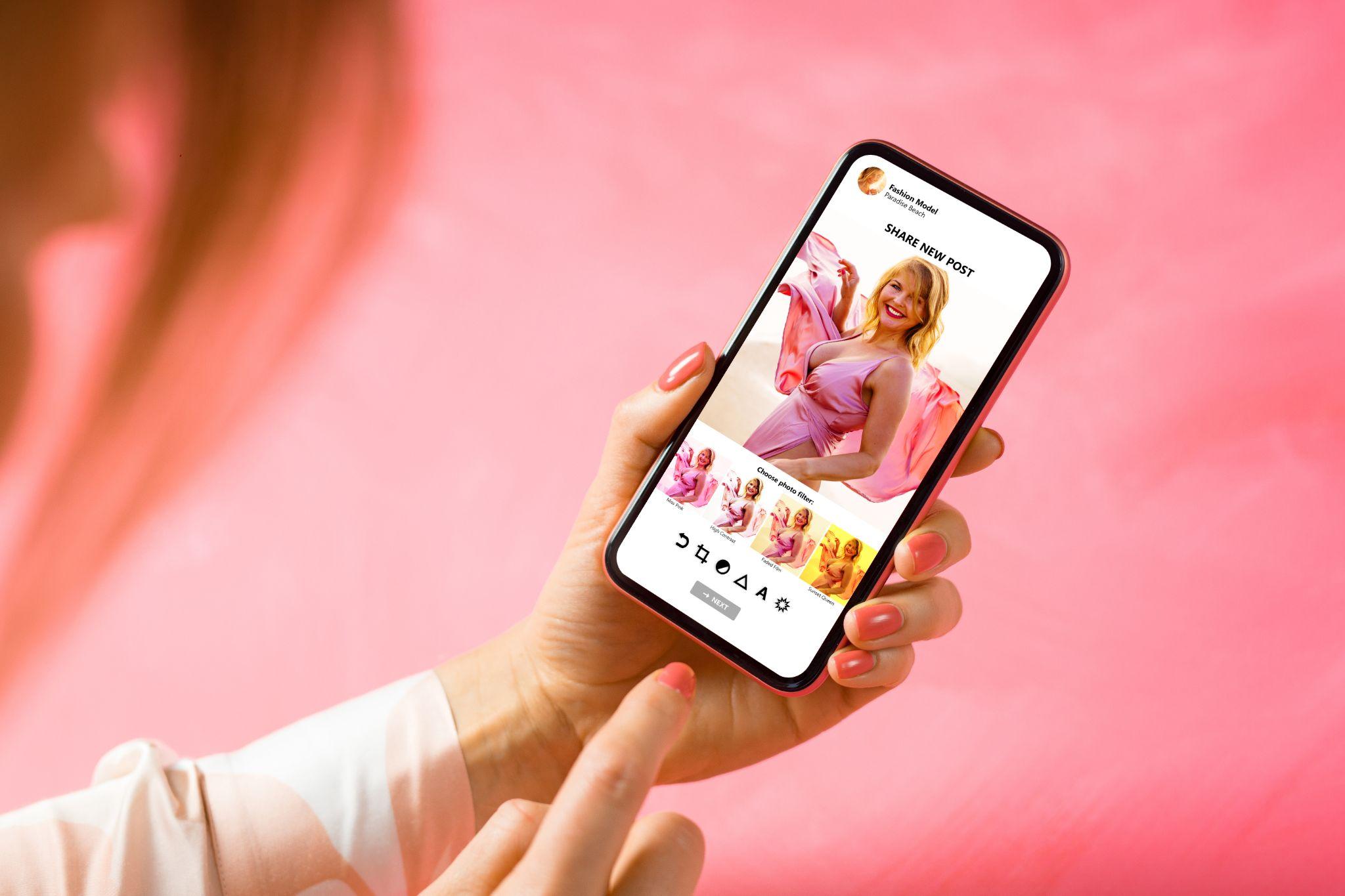
The online apparel market is a massive $1.5 trillion industry, and the U.S. leads the way, with $351 billion in revenues in 2023.
Online fashion brands know the power of social media to showcase and sell their products. Social media platforms have responded in kind by enabling in-app shopping to help retailers reach their customers where they are online.
Social commerce sales are expected to triple by 2025, with platforms like Instagram and TikTok leading the way in new purchases. If you’re an apparel brand, marketing on social media is a must. But you need a good strategy. That might include hiring a social media expert to help you take your marketing efforts to new heights.
Whether you decide to hire an expert on social media marketing for fashion brands or forge ahead on your own, stick with us, because we’re going to cover exactly how to get your fashion brand seen on social.
Marketing your clothing brand on social media is a must, but it can be time consuming. So, it’s important to choose the right platforms. Here’s a snapshot of the best platforms for fashion marketing.
With 3 billion monthly active users worldwide, Facebook is the world’s most popular social media platform. And it’s one of the best platforms for social media content for clothing brands.
Facebook’s vast user base and comprehensive advertising tools make it one of the best places to reach a diverse audience. The platform’s advanced targeting tools allow you to home in on specific demographics, interests, and behaviors, so you can tailor your ads to reach your target demo.
Use Facebook to build brand awareness, run targeted ad campaigns, and engage with your community through posts, stories, and live videos. It’s also ideal for sharing long-form content and customer testimonials.
More than 130 million Instagram users interact with shopping-related posts each month. The visual-centric platform is perfect for showcasing high-quality images and videos of your apparel. It’s why Instagram is considered one of the best platforms when it comes to social media marketing for fashion brands.
Features like Stories, Reels, and shoppable posts provide dynamic ways to display your products and create engaging content. Use Instagram to showcase your apparel through beautiful, eye-catching visuals. It’s also an excellent platform for brand storytelling, influencer collaborations, and creating a visually cohesive brand identity.
Pinterest is a “happy” platform—nearly 8 out of 10 users say they feel positive after interacting with the site. What’s more, 85% of Pinners have made a purchase based on Pins from brands, according to the company’s own data. That makes the platform a potential goldmine for fashion marketers.
Pinterest’s pinboard-style format makes it easy to advertise your apparel in a way that’s aesthetically pleasing and easy to navigate. Use Pinterest to inspire potential customers with curated collections and style guides or to highlight seasonal trends and DIY fashion ideas through pins that link directly to your online store.
TikTok’s explosive growth and young demo make it a prime platform for connecting with Gen Z consumers. TikTok boasts more than 1.5 billion monthly active users who love authentic content. The platform’s emphasis on short-form video content gives you leeway to get fun and creative with your ads and posts.
TikTok is an ideal platform for budding fashion brands. Use it to showcase new collections, launch viral challenges, and collaborate with influencers.
YouTube is the go-to platform for long-form video content. With 2.5 billion global active users, it’s a powerful tool for reaching people across demographics, and the platform’s powerful algorithm can help your content reach a wide audience over time.
Larger fashion brands do especially well on the platform, thanks to their ability to amass huge numbers of followers. YouTube is best offering expert advice, detailed product demonstrations, and tutorials. Use it for vlogs, fashion hauls, lookbooks, and interviews with designers or influencers.
Small and budding fashion brands may be better off marketing on Facebook or Instagram, but if you decide to leverage YouTube as a marketing channel, you can also earn passive income by showing ads with your videos.
Snapchat reaches 75% of the 13- to 34-year-old population, which is great news for fashion brands with a younger target demo.
Snapchat’s ephemeral nature encourages quick, authentic interactions. The platform’s special features, like AR lenses and filters, give you the opportunity to engage users in a unique way.
While most users aren’t on the platform to discover new products, people are 34% more likely to purchase a product they see advertised on Snapchat versus other platforms. They’re also much more likely to recommend that product to a friend.
Use Snapchat to create a sense of urgency with time-limited offers and sneak peeks. Snapchat’s young audience loves interactive and playful content, so draw them in with behind-the-scenes glimpses, AR experiences, and exclusive discounts.

In the competitive world of fashion, having a robust social media strategy is not just beneficial—it’s essential. Here’s why:
There are 4.8 billion social media users worldwide. That’s well over half the world’s population. Social media platforms offer unparalleled reach, allowing you to present your brand to a global audience.
Gucci is a great case study on how brands can use social media to their advantage. The company has mastered using Instagram’s visual-centric platform to amass more than 52 million followers, reinforcing its status as a leading luxury brand.
Having a strong presence on social media will help you stay top of mind with your target demo. Consistency is key. If you’re an emerging brand without the staff to manage your social media channels, consider hiring an expert.
To win out over the competition, you need to know and understand your competitors—their strengths and weaknesses and how your target audience perceives them. This is where competitive analysis comes in.
Monitoring competitors on social media can provide valuable insights into what rival brands are up to. With this information, you can refine your own strategy and identify opportunities to differentiate your brand.
Social media platforms now offer integrated shopping features that make it easier for customers to purchase directly from your posts. Instagram’s Shopping feature, for example, allows users to explore and buy products seamlessly, driving significant sales for fashion brands.
These features reduce friction in the buying process and make shopping more interactive and engaging.
Consumers today want to see authentic and honest brand personalities on social media. By responding to comments, sharing user-generated content, and hosting live events, you can create a sense of connection with your target audience and build a loyal following.
Direct interactions can also give you valuable feedback, so you can improve your offerings and exceed your customers’ expectations.
Want to maximize your social media efforts? Try these proven social media marketing strategies for clothing brands.
A content calendar helps you plan your posts in advance, ensuring a consistent flow of content. Being organized will also help you align your social media activities with seasonal promotions and events and maintain a balanced mix of product showcases, behind-the-scenes content, and user engagement posts.
Here’s how to do it:
Posting regularly keeps your brand top of mind. It’s a core part of social media marketing for fashion brands. Consistency is vital, as it signals to social media algorithms that your account is active. This increases the chances that your posts will be shown to more users.
How often you should post on social media depends on the platform. Per data from Hootsuite, the sweet spot for Twitter (X) is 2-3 times per day, while once a week is better on Pinterest. One thing is for sure: Posting regularly will bring you more website traffic, engagement, and conversions.

Partnering with influencers is one of the newest and best social media marketing strategies for clothing brands. Influencers can amplify your reach and add credibility to your brand. Because they’ve established trust with their followers, their endorsements could lead to higher engagement and conversions for your products.
It’s all about finding the right partners. Look for influencers whose style and values are a match for your brand. You’ll also want to do some research on the influencer. Who follows them, who have they collaborated with in the past, and how engaged are their followers?
Once you’ve done your homework, reach out to them about a possible collaboration. Show genuine interest in their work and pitch the benefits of working with your company. If you’re nervous about reaching out to an influencer, work with an agency experienced in digital marketing for fashion brands.
Collaborating with bloggers and fashion writers on guest posts can enhance your brand’s credibility while helping you reach new audiences.
Guest posts provide fresh perspectives and content that adds value for your followers. And it’s a great way to build relationships with other industry experts and influencers, opening up opportunities for future collaborations.
Posts that include backlinks to your website can bring you more traffic. It’s an affordable way to boost your SEO rankings. Meanwhile, publishing posts on reputable sites can enhance your brand’s credibility and position you as an authority in the fashion industry.
Active engagement with your followers is the key to building a loyal community. Respond to comments, participate in conversations, and show appreciation for your followers. When followers feel connected to your brand, they’re more likely to become brand advocates, driving word-of-mouth marketing.
The fashion industry is constantly evolving. Monitor trending topics, hashtags, and new features on social media platforms. Adapt your content to reflect these trends, ensuring your brand stays relevant and appealing to your audience.
Keep your audience informed about the latest trends by sharing outfit ideas, style guides, and trend forecasts. Create lookbooks featuring the season’s must-have pieces and offer how-to guides on how to style them.
Paid advertising can significantly boost your reach and visibility by helping you reach a larger audience than organic posts alone.
Use the advanced targeting options on social media platforms like Facebook to reach niche demographics and target their interests. You can track and analyze the results of your ads using the platform’s analytics tools and fine tune your strategy based on the results.
Consistent paid ad campaigns will keep your brand top of mind for potential customers, helping you build long-term brand recognition. This is especially helpful for new fashion brands.
Humans have been having a love affair with “moving pictures” since the late 1800s, and it’s still going strong! Videos are a dynamic content format that grabs attention more effectively than static posts. Here are some ways to maximize Reels and videos:
Social media marketing experts can help you optimize your marketing strategy on social. They can provide tailored advice, manage your campaigns, and help you achieve your marketing goals efficiently. They bring industry insights and proven strategies to the table, ensuring your brand stands out in a crowded market.
For example, Socialfly helped the activewear brand ZENTOA launch their social channels with daily teaser content that gave tantalizing glimpses of the company’s ultra-comfy and stylish activewear, while showcasing the company’s focus on warrior spirit.
The goal was to drive purchases and set the company apart in the crowded activewear space. Using sleekly shot production videos and behind-the-scenes captures, Socialfly helped ZENTOA reach customers with the company’s signature message of personal empowerment.
Connecting with your audience can help you build a loyal community, and user-generated content (UGC) is a powerful tool to do it. UGC not only provides authentic content but also makes your followers feel valued and involved. Here are some ways to capitalize on user-generated content:
![]()
To succeed and thrive, you need to know how your audience feels about your brand and products. This insight helps you make informed decisions and improve your offerings in the name of boosting customer satisfaction. Here are some ways to track customer sentiment:
Monitor brand hashtags. Search for hashtags that include your brand name to see what people are saying about you. This can provide real-time feedback and highlight common themes in customer opinions.
Use surveys. Conduct surveys to collect customer feelings and attitudes. Ask specific questions about their experiences with your products and services to gather detailed feedback.
Analyze social media comments. Regularly review comments on your social media posts. Look for patterns in the feedback to understand what customers like or dislike.
Track online reviews. Keep an eye on reviews on platforms like Google, Yelp, and product-specific review sites. These reviews often contain detailed insights into customer satisfaction and areas for improvement.
Socialfly can help you take your social media marketing efforts to the next level. Our team of digital natives will help you increase engagement and boost brand awareness on the platforms your target audience uses most.
We leverage advanced data-tracking tools to analyze the success of your campaigns, and we’re always looking for new and innovative ways to improve your brand’s social media strategy.
Check out our work and get in touch to learn more about how we can help you reach your target audience and get more for your marketing dollars.